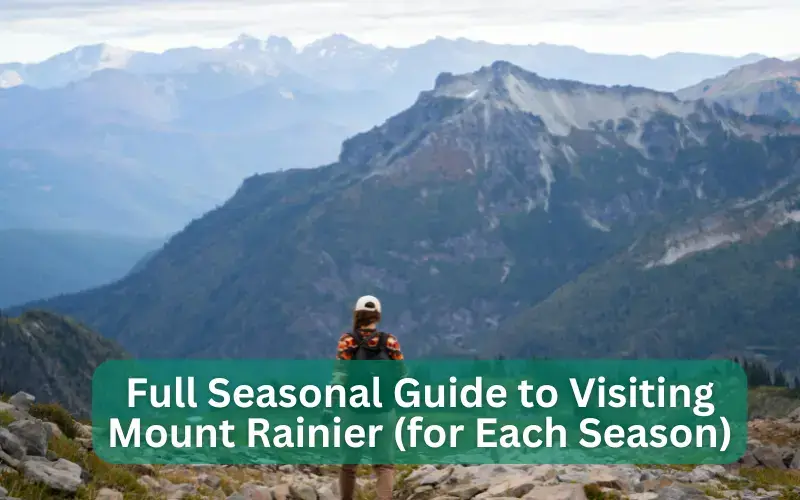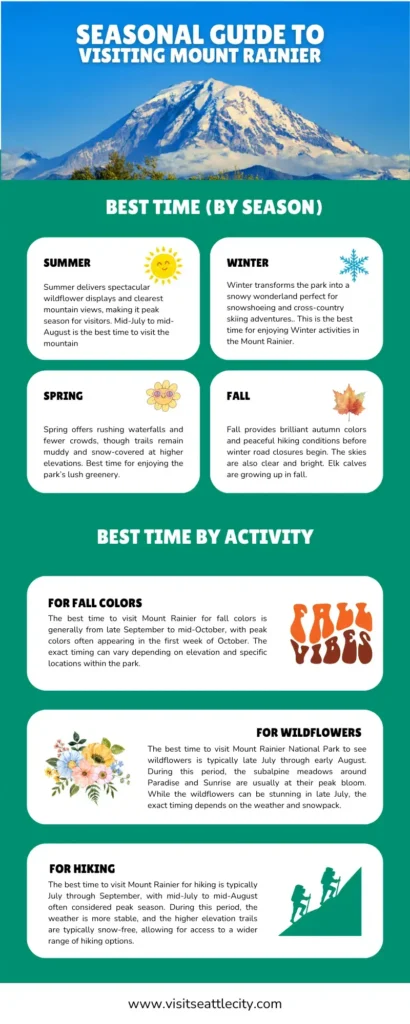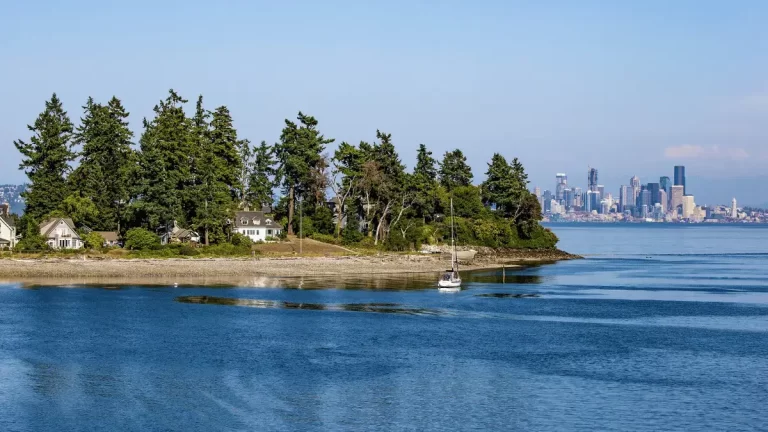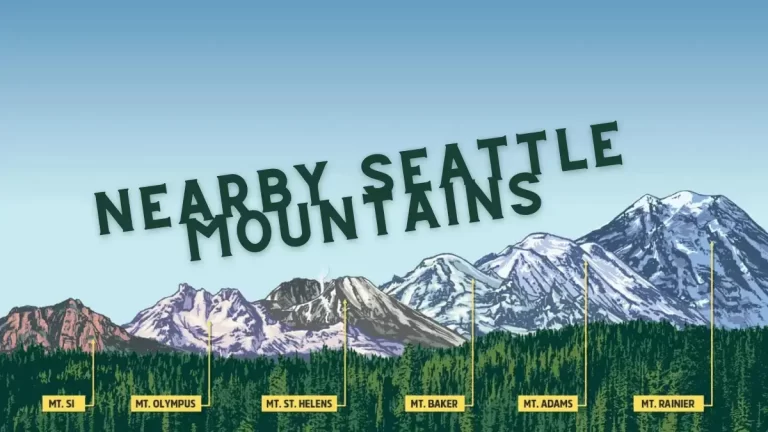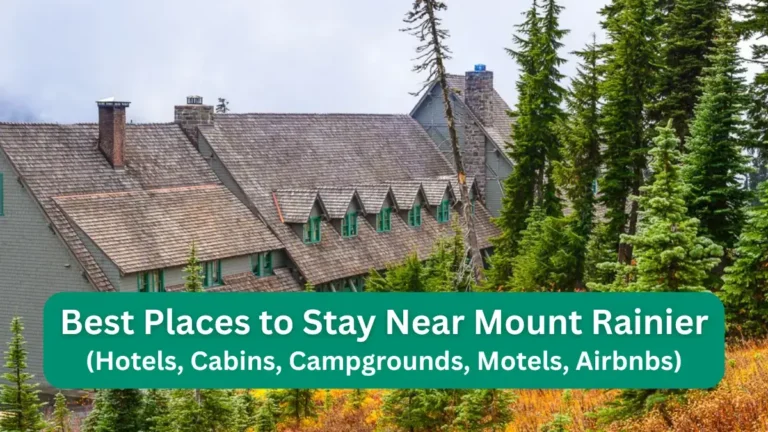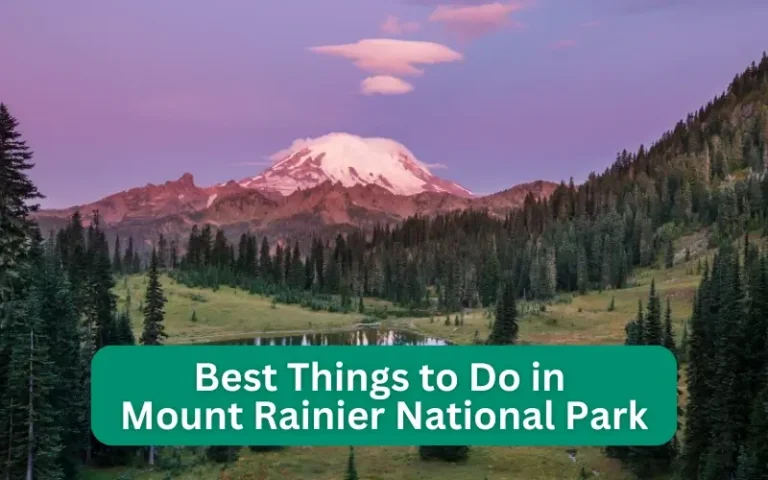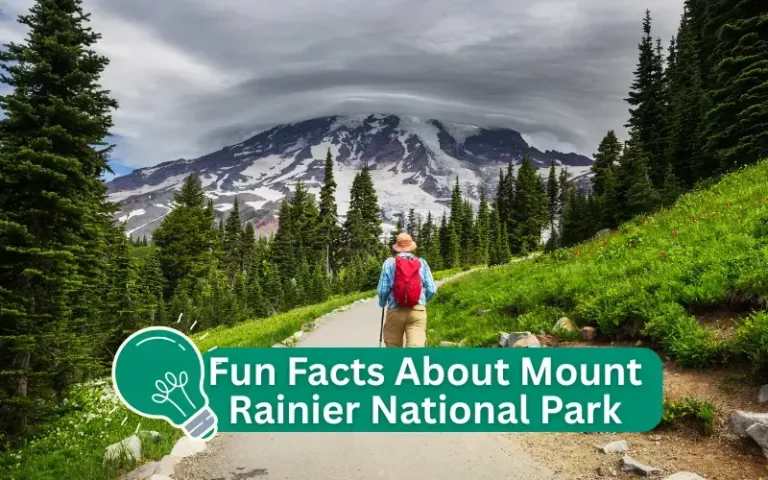Welcome to the full seasonal guide that covers the best time to visit Mount Rainier National Park in different seasons. It also covers the best time for different activities. I’ll also share Mount Rainier’s weather by month. And I’ll answer some questions about when to visit the mountain.
Full Seasonal Guide to Visiting Mount Rainier in 2025
Mount Rainier is one of the most spectacular of the seven legendary mountains near Seattle. It’s about 70 miles from the city and is a popular day trip from Seattle. The mountain is known for dramatic seasonal changes and stunning natural beauty. You must prepare for changing weather and check park conditions before going. It rises 14,411 feet and is covered by glaciers.
Visitors can enjoy different experiences all year.
The best time to go to Mount Rainier National Park is summer from mid-July to mid-August for wildflower blooms and ideal hiking conditions. But fall, especially October, is a good time for watching vibrant fall colors.
And spring, from April to June, is a good time to enjoy waterfalls and blooming meadows. Winter is an awesome time to visit the mount for snow sports like skiing and snowshoeing. Read our Seattle weather guide for more.
Here’s a quick overview:
- Mid-July to mid-August offers the best weather and full trail access
- Timed Entry Reservations are required for Sunrise area during peak season
- Winter provides solitude but limits access to Paradise and Longmire areas only
Best Time to Visit Mount Rainier National Park (for Each Season)
The best time to visit Mount Rainier National Park is summer from mid-July to mid-August for watching wildflowers, hiking, and other activities. However, if you’re interested in winter activities, consider visiting between November and March this year.
| Best Times to Visit Mount Rainier by Activity | |
| For Fall Colors | Late September to early November |
| For Wildflowers | Mid July to early August |
| For Hiking | Mid-July to September |
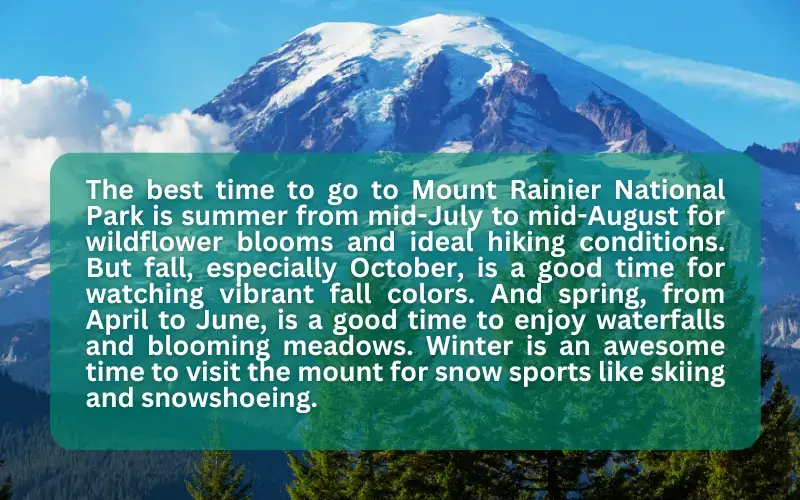
- Summer delivers spectacular wildflower displays and clearest mountain views, making it peak season for visitors.
- Winter transforms the park into a snowy wonderland perfect for snowshoeing and cross-country skiing adventures.
- Spring offers rushing waterfalls and fewer crowds, though trails remain muddy and snow-covered at higher elevations.
- Fall provides brilliant autumn colors and peaceful hiking conditions before winter road closures begin.
Let me share what to expect when visiting Mount Rainier in different seasons.
Visiting Mount Rainier in the Summer (June — August)
June brings lush green landscapes at lower elevations while Reflection Lakes remain frozen until mid-July. The Mount Rainier wildflowers burst into spectacular displays from mid-July through mid-August. This creates flower-filled meadows throughout Paradise.
Paradise receives over 2.4 million visitors annually, with most arriving during these peak months. Clear skies provide the best odds for unobstructed mountain views. However, lenticular clouds often form over the summit creating striking “flying saucer” shapes.
The Paradise Inn in the area is one of the best places to stay near Mount Rainier. The historic inn has 121 guestrooms but does not offer modern amenities like TV or internet.
Timed Entry Reservations are mandatory for the Sunrise area from July 11th through September 1st daily, then weekends through October 26th. The $2 non-refundable reservation fee must be booked through Recreation.gov in addition to park entrance passes.
RAMROD (Ride Around Mount Rainier in One Day) cycling event takes place in July. The event attracts thousands of cyclists from across the US. Summer temperatures range from 40°F to 70°F. And visitors often experience the strange sensation of walking on snowfields while sweating from heat in June. Find out more fun facts about Mount Rainier here.
Visiting Mount Rainier in the Winter (December — February)
Paradise receives an average of 67 feet of snow annually, with a record-breaking 703 inches falling in 2017 alone. Only the Nisqually and Carbon River entrances remain open during winter months. The Carbon River Road closes to vehicles just inside the entrance but remains accessible for bicycles and pedestrians. Rangers lead guided snowshoe walks every weekend at Paradise. It’s perfect for beginners learning winter recreation.
Vehicle access between Longmire and Paradise operates on weekends only during winter months. Visitors must exit Paradise by specific afternoon times. They must leave through the Longmire gate. These times change based on weather conditions.
Essential winter gear includes microspikes, gaiters, and extra socks. Sunglasses are needed for snow glare. Headlamps with extra batteries are important for shorter daylight hours.
Visiting Mount Rainier in the Spring (March — May)
March and April feel more like winter with snow still covering most trails and requiring mountaineering boots for challenging hikes. National Park Week occurs in April, offering special programs and potential fee-free days.
Snowmelt creates robust waterfalls and rushing rivers throughout the park. Spontaneous temporary waterfalls appear as ice formations melt. Lower elevation Mount Rainier hiking trails like Carter Falls and Silver Falls begin clearing by late April and May.
Post-holing becomes a serious concern when hiking without snowshoes. You can sink knee-deep into soft snow with each step. Stevens Canyon Road and Chinook Pass reopen around Memorial Day weekend, expanding access options.
Waterproof boots and microspikes are absolutely essential for navigating muddy, icy trail conditions. The Longmire area offers the most accessible hiking options during early spring, with the museum and National Park Inn providing indoor alternatives during poor weather.
Visiting Mount Rainier in the Fall (September — November)
Early fall lasts from late September through early October in Mount Rainier. During this time, vibrant crimson, orange, and yellow foliage appears throughout meadows and forests. School schedules reduce crowd sizes compared to busy summer months. This creates perfect conditions for peaceful hiking.
The Sunrise corridor generally closes sometime in October. The exact time depends on snowfall. Stevens Canyon and other roads close around the same time. Cyclists particularly love fall visits. There are fewer vehicles sharing mountain roads then.
Wildfire season typically ends by fall, making trip planning more predictable than spring’s variable conditions. Many Mount Rainier camping opportunities remain available before winter closures begin in late October.
Road conditions change rapidly as snow returns in fall in Mount Rainier. You must check National Park Service websites and social media updates. The brief window between summer crowds and winter limitations makes fall ideal for experienced hikers. They can seek solitude on trails like Skyline Trail and Naches Peak Loop.
Mount Rainier National Park Weather by Month
| Month | Paradise High (°F) | Paradise Low (°F) | Longmire High (°F) | Longmire Low (°F) | Ohanapecosh High (°F) | Ohanapecosh Low (°F) |
|---|---|---|---|---|---|---|
| January | 33 | 21 | 36 | 24 | 39 | 30 |
| February | 35 | 22 | 40 | 26 | 41 | 30 |
| March | 37 | 22 | 44 | 28 | 42 | 32 |
| April | 44 | 27 | 53 | 32 | 58 | 35 |
| May | 50 | 32 | 62 | 37 | 70 | 41 |
| June | 56 | 44 | 66 | 43 | 77 | 45 |
| July | 64 | 44 | 75 | 47 | 78 | 49 |
| August | 63 | 43 | 74 | 47 | 81 | 48 |
| September | 57 | 39 | 68 | 43 | 72 | 43 |
| October | 48 | 33 | 57 | 38 | 57 | 36 |
| November | 41 | 37 | 45 | 31 | 39 | 27 |
| December | 34 | 22 | 39 | 28 | 34 | 23 |
FAQs for Seasonal Guide to Visiting Mount Rainier
Let me answer some of the common questions now.
What’s the best time of year to visit Mount Rainier National Park?
The best time of year to visit Mount Rainier National Park is from mid-July through August for hiking and watching wildflowers. During this time, most trails are snow-free. The meadows are full of wildflowers, creating stunning views. The weather is usually dry and warm, perfect for outdoor activities.
How many days do you need in Mount Rainier National Park?
To truly explore Mount Rainier National Park, plan for at least two full days, though three days is ideal. This gives you time to visit areas like Paradise and Sunrise. You’ll also have the chance to enjoy hiking and other activities. If you love hiking or prefer a slower pace, spending a week or more is also a great option.
What time should I get to Mount Rainier?
To avoid long waits, try to enter Mount Rainier before 10:00 am or after 2:30 pm. Parking is limited, especially during summer weekends and holidays. On busy days, you could face wait times of over an hour at the Nisqually and White River Entrances.
When to see wildflowers at Mount Rainier?
Wildflowers usually start blooming by mid-July, and the peak bloom typically occurs in early August. The timing of the bloom varies with weather conditions, but by August, the meadows are usually in full color and spectacular to see.

